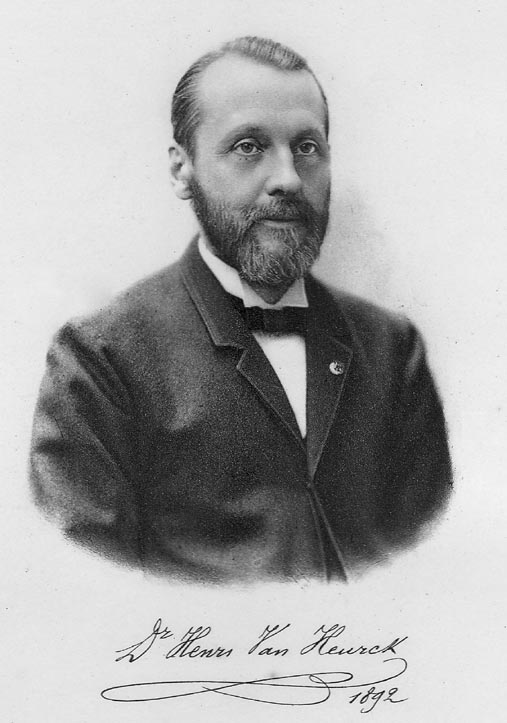 The
famous Belgian microscopist, Henri Van Heurck(1839-1909) was the
manager of his family business manufacturing paints and varnishes. He
became famous as a botanist, expert microscopist, photomicrographer,
and especially diatomist. More than one diatom species is named in his
honor. The basic plan for the Van Heurck stand was based on the earlier
Edinburgh stand, a model devised with the advice of an Edinburgh
professor. For more historical information about the various models of
the Edinburgh microscope see the Edinburgh
B page and the Edinburgh
H page.
The
famous Belgian microscopist, Henri Van Heurck(1839-1909) was the
manager of his family business manufacturing paints and varnishes. He
became famous as a botanist, expert microscopist, photomicrographer,
and especially diatomist. More than one diatom species is named in his
honor. The basic plan for the Van Heurck stand was based on the earlier
Edinburgh stand, a model devised with the advice of an Edinburgh
professor. For more historical information about the various models of
the Edinburgh microscope see the Edinburgh
B page and the Edinburgh
H page.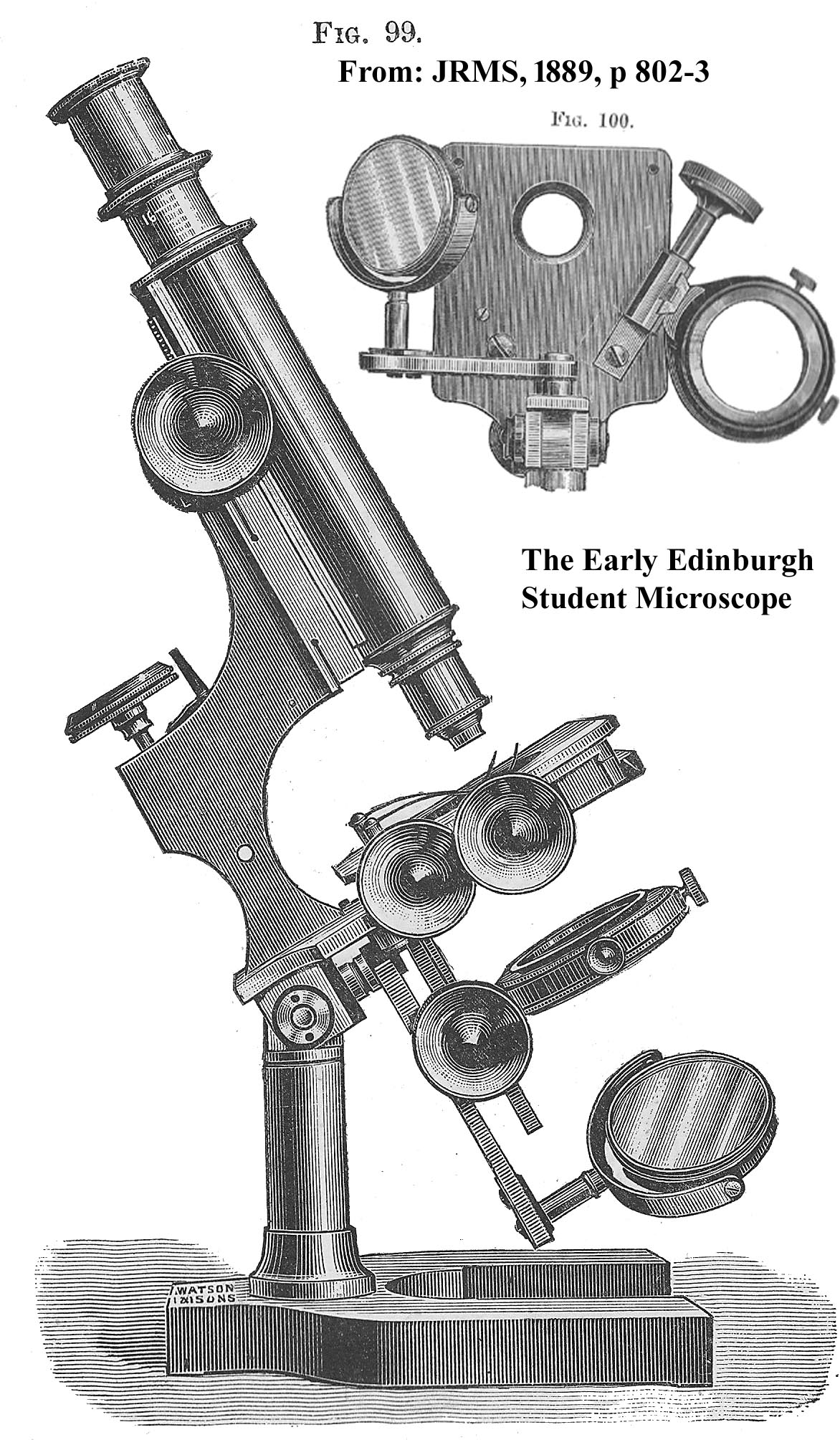 Watson
& Sons had been making microscopes since about 1874. For some
time
in their early production, their microscopes were similar to other
contemporary makers, but soon they started to produce a variety of
interesting designs, including their own variation of the Walter
Bulloch Biological No. 2, and also a version loosely based on Wale's
New Working Microscope. In 1887, Dr Edington, a Lecturer in
Bacteriology from the University of Edinburgh suggested the first form
of the Edinburgh stand; according to Watson's delivery records, the
first example was sold on November 29, 1887. This stand was the
inspiration for the Van Heurck stand, and like the Van Heurck, started
out with a continental foot, but was soon ordered more often with a
tripod
foot. Like the Van Heurck, it was improved progressively over the
years. This culminated in the Edinburgh 'D' and 'H' models, (an example
of 'D' is shown to the left), which had most of the basic features of
the (later) 'Royal' model. In fact, when the Royal was first introduced, it was
actually slightly smaller than the Edinburgh H. The various Edinburgh
stands were at first indicated by the numbers 1,2,3, and 4, but by
1890, the letters A,B,C and D were used.
Watson
& Sons had been making microscopes since about 1874. For some
time
in their early production, their microscopes were similar to other
contemporary makers, but soon they started to produce a variety of
interesting designs, including their own variation of the Walter
Bulloch Biological No. 2, and also a version loosely based on Wale's
New Working Microscope. In 1887, Dr Edington, a Lecturer in
Bacteriology from the University of Edinburgh suggested the first form
of the Edinburgh stand; according to Watson's delivery records, the
first example was sold on November 29, 1887. This stand was the
inspiration for the Van Heurck stand, and like the Van Heurck, started
out with a continental foot, but was soon ordered more often with a
tripod
foot. Like the Van Heurck, it was improved progressively over the
years. This culminated in the Edinburgh 'D' and 'H' models, (an example
of 'D' is shown to the left), which had most of the basic features of
the (later) 'Royal' model. In fact, when the Royal was first introduced, it was
actually slightly smaller than the Edinburgh H. The various Edinburgh
stands were at first indicated by the numbers 1,2,3, and 4, but by
1890, the letters A,B,C and D were used. 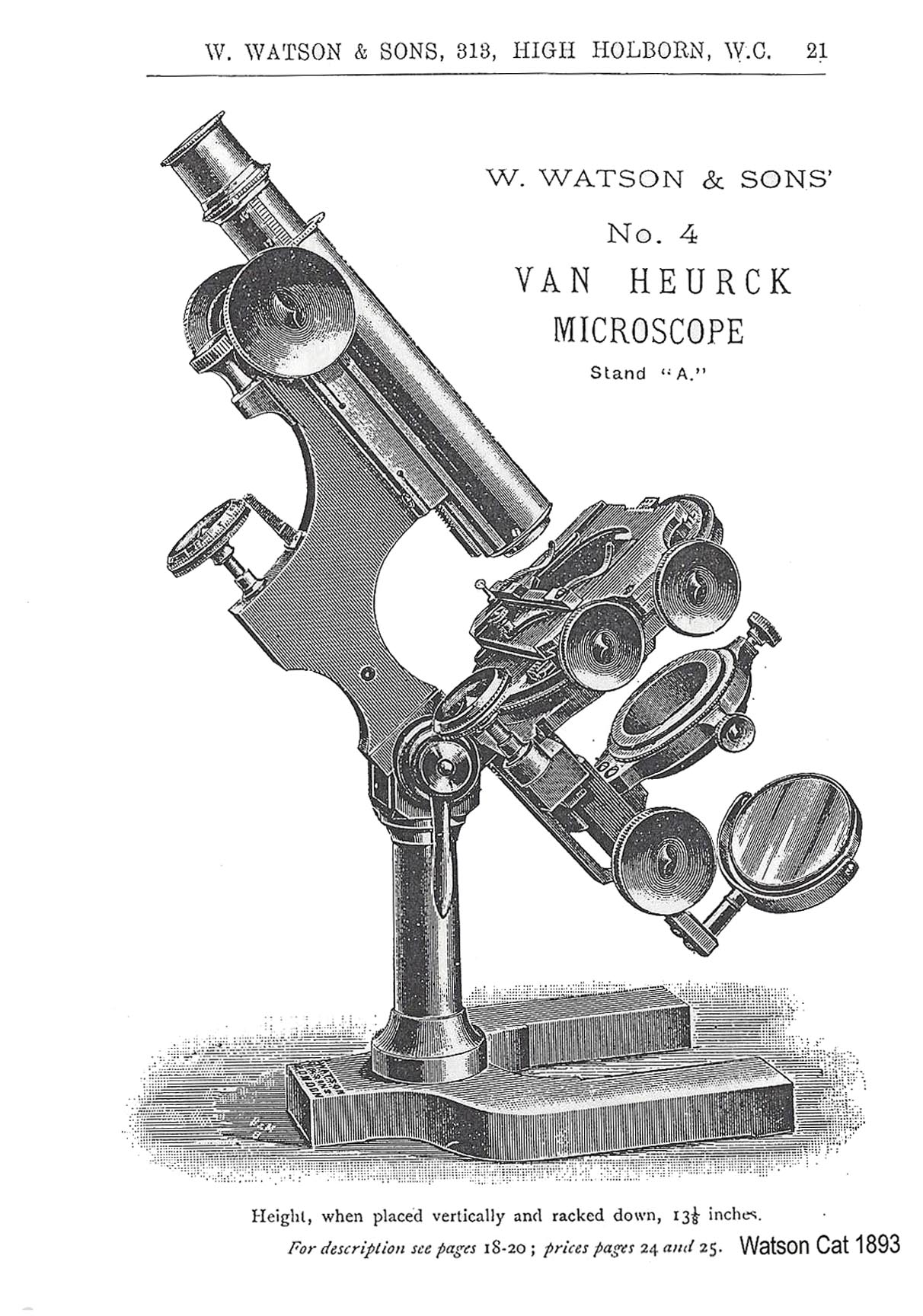 In
1889 or before, with all of his expertise, Van Heurck
suggested
the design of a microscope to his specifications, and this was the
first model of the Van Heurck microscope made by W. Watson and
Sons; the prototype was apparently delivered to Van Heurck in 1889*,
but there is no entry in the Watson delivery book for the prototype.
The first entry for a Van Heurck in the Delivery Books
was March of 1891. It was also
pictured in the first edition of Van Heurck's book also dated
1891.
This first version is identical to the 'Watson No. 4 Van Heurck Stand
A' seen in the 1893 catalog. Study of the illustrations shows that this
initial Van Heurck differed from the original Edinburgh mainly in two
features-the fine adjustment for the substage, and the ability to
rotate the mechanical stage. Van Heurck preferred to do all of his
photomicrography with a vertically oriented microscope which is why he
preferred his microscope to be made with a continental 'horseshoe' foot
and supported on a single pillar, so as not to interfere with substage
adjustments during the, (then) delicate operation, of photomicrography
with high power objectives. At the same time, many others preferred the
horizontal position for photography. For this reason, his stand was
also offered with the more stable English tripod foot which provided a
much more stable stand for photography in the horizontal position. Many
more examples with an English tripod exist than with the horseshoe
foot, as the tripod quickly became more popular.
In
1889 or before, with all of his expertise, Van Heurck
suggested
the design of a microscope to his specifications, and this was the
first model of the Van Heurck microscope made by W. Watson and
Sons; the prototype was apparently delivered to Van Heurck in 1889*,
but there is no entry in the Watson delivery book for the prototype.
The first entry for a Van Heurck in the Delivery Books
was March of 1891. It was also
pictured in the first edition of Van Heurck's book also dated
1891.
This first version is identical to the 'Watson No. 4 Van Heurck Stand
A' seen in the 1893 catalog. Study of the illustrations shows that this
initial Van Heurck differed from the original Edinburgh mainly in two
features-the fine adjustment for the substage, and the ability to
rotate the mechanical stage. Van Heurck preferred to do all of his
photomicrography with a vertically oriented microscope which is why he
preferred his microscope to be made with a continental 'horseshoe' foot
and supported on a single pillar, so as not to interfere with substage
adjustments during the, (then) delicate operation, of photomicrography
with high power objectives. At the same time, many others preferred the
horizontal position for photography. For this reason, his stand was
also offered with the more stable English tripod foot which provided a
much more stable stand for photography in the horizontal position. Many
more examples with an English tripod exist than with the horseshoe
foot, as the tripod quickly became more popular.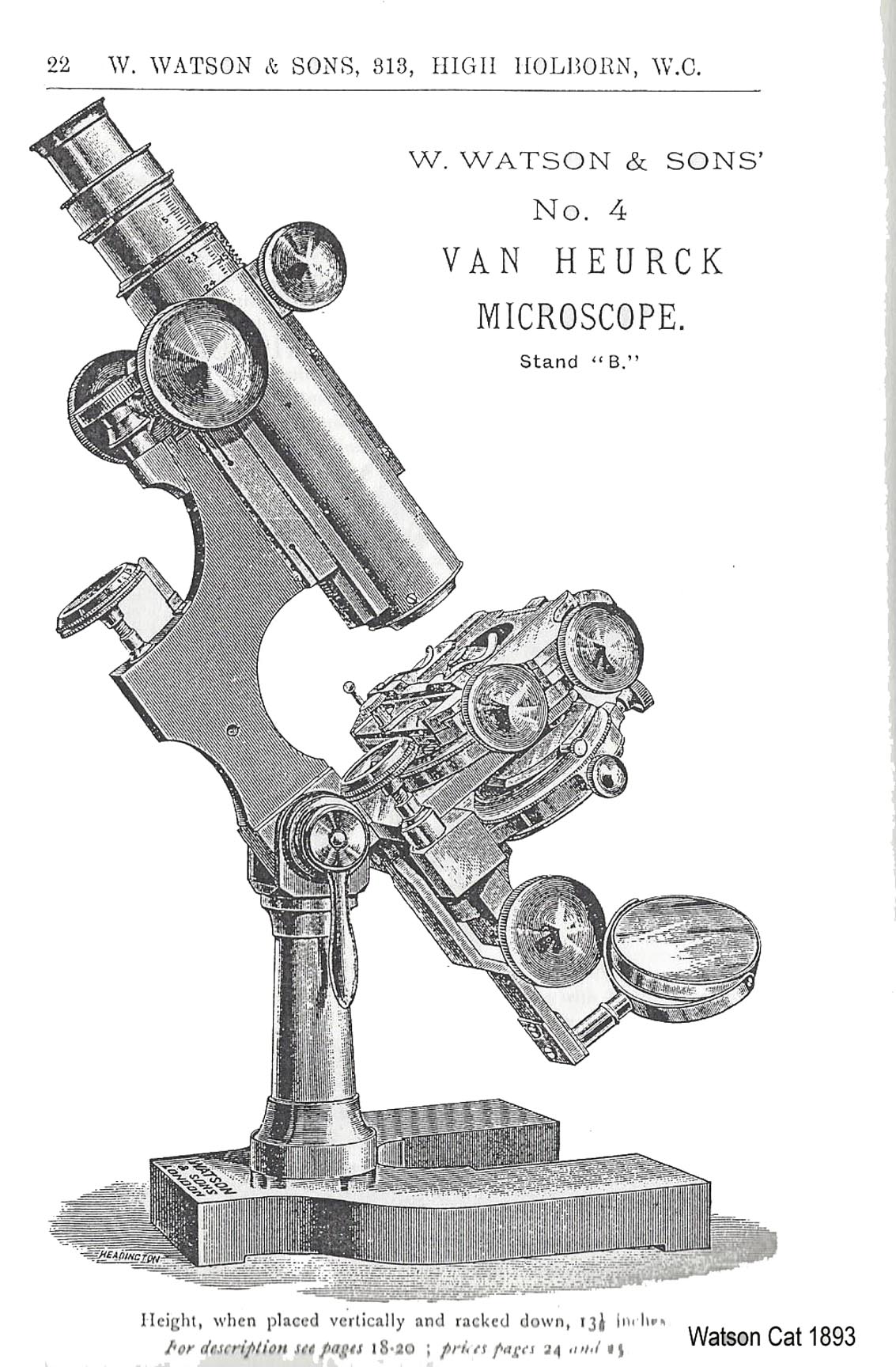 As noted above, the Van Heurck instrument, as designed by the
diatomist, was at first provided on a continental foot with a single pillar. Early examples had a standard one inch diameter main optical tube, as pictured in the image in the preceding paragraph. In the 1893 catalog the 'No. 4 Van Heurck Stand A' had a 1 inch diameter main optical tube with a single calibrated draw tube with tube length variable from about 160 mm to 260 mm. The 'No. 4 Van Heurck Stand B,' as shown to the left, had a double drawtube, the lower draw wider, (but still only 1.5 inches in diameter), and controlled by rack and pinion. In the 'B' stand the combined tube length could be varied from about 142 to 305 mm. It could be ordered with a continental foot, or for a slightly higher price with a tripod foot. The Van Heurck was apparently not yet considered the 'top of the line' instrument as No. 1 was the impressive 'Watson Swinging Substage Microscope,' No. 2 was the 'Scientist's,' and No 3. was the 'Research.' In 1894, the first'Grand Van Heurck' was listed in the Watson delivery books. It was not listed as such in the 1893 catalog, but the 'Exhibition Van Heurck b' had most if not all of the features of what was soon to be called the 'Grand Van Heurck' except it was all finished in bright lacquered brass.
As noted above, the Van Heurck instrument, as designed by the
diatomist, was at first provided on a continental foot with a single pillar. Early examples had a standard one inch diameter main optical tube, as pictured in the image in the preceding paragraph. In the 1893 catalog the 'No. 4 Van Heurck Stand A' had a 1 inch diameter main optical tube with a single calibrated draw tube with tube length variable from about 160 mm to 260 mm. The 'No. 4 Van Heurck Stand B,' as shown to the left, had a double drawtube, the lower draw wider, (but still only 1.5 inches in diameter), and controlled by rack and pinion. In the 'B' stand the combined tube length could be varied from about 142 to 305 mm. It could be ordered with a continental foot, or for a slightly higher price with a tripod foot. The Van Heurck was apparently not yet considered the 'top of the line' instrument as No. 1 was the impressive 'Watson Swinging Substage Microscope,' No. 2 was the 'Scientist's,' and No 3. was the 'Research.' In 1894, the first'Grand Van Heurck' was listed in the Watson delivery books. It was not listed as such in the 1893 catalog, but the 'Exhibition Van Heurck b' had most if not all of the features of what was soon to be called the 'Grand Van Heurck' except it was all finished in bright lacquered brass. 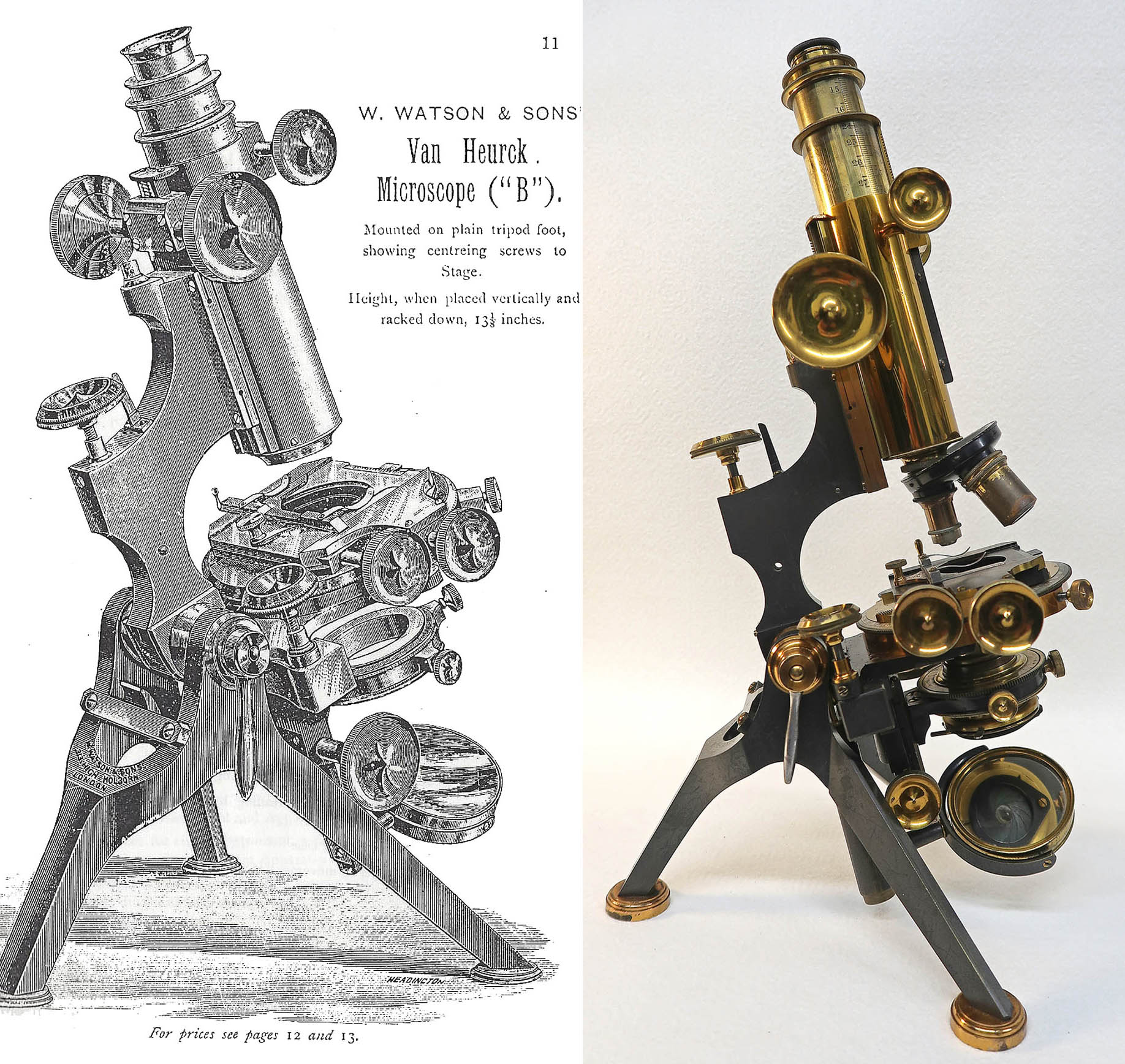 In the 1896 catalog, stand 'A' was no longer listed, but the usual Van Heurck was
still called the 'B.' Also in 1896, the 'Grand Model Van
Heurck Microscope Stand' was first listed in the catalog. At that time it was listed as identical to the B stand except for three new features: 1)concentric controls for the mechanical stage (after Terrell), 2)complete rotation of the stage, and 3)a
slightly larger foot with the Grand, the spread of the foot 'more than ten inches'. Note however that the first listing in the Delivery Books for a microscope named as a 'Grand Van Heurck' was in 1894, serial number 3517.
In the 1896 catalog, stand 'A' was no longer listed, but the usual Van Heurck was
still called the 'B.' Also in 1896, the 'Grand Model Van
Heurck Microscope Stand' was first listed in the catalog. At that time it was listed as identical to the B stand except for three new features: 1)concentric controls for the mechanical stage (after Terrell), 2)complete rotation of the stage, and 3)a
slightly larger foot with the Grand, the spread of the foot 'more than ten inches'. Note however that the first listing in the Delivery Books for a microscope named as a 'Grand Van Heurck' was in 1894, serial number 3517.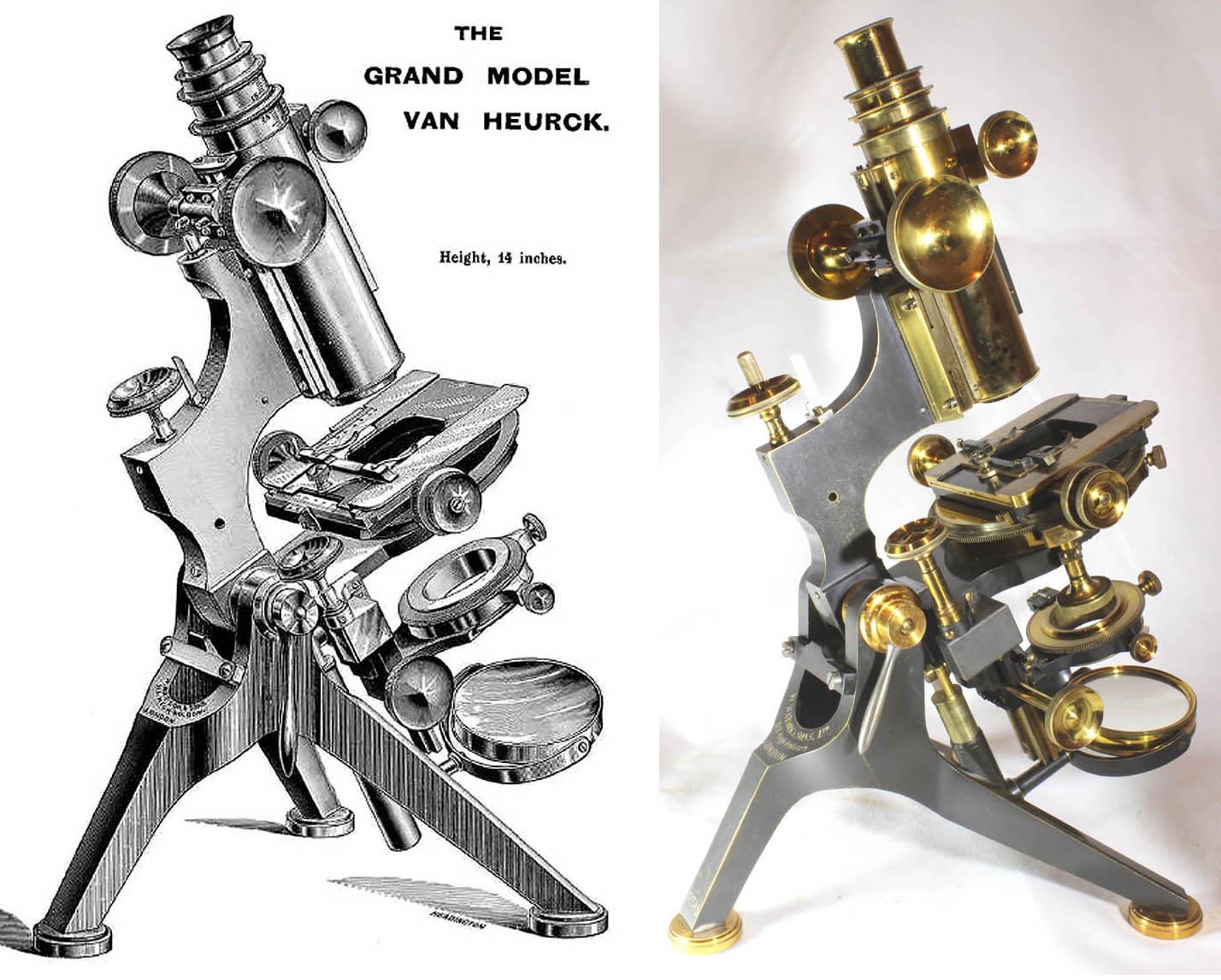 Shown to the left is the 'Grand Van Heurck' first sold in 1894 and first listed in the catalog about 1896.
Shown to the left is the 'Grand Van Heurck' first sold in 1894 and first listed in the catalog about 1896.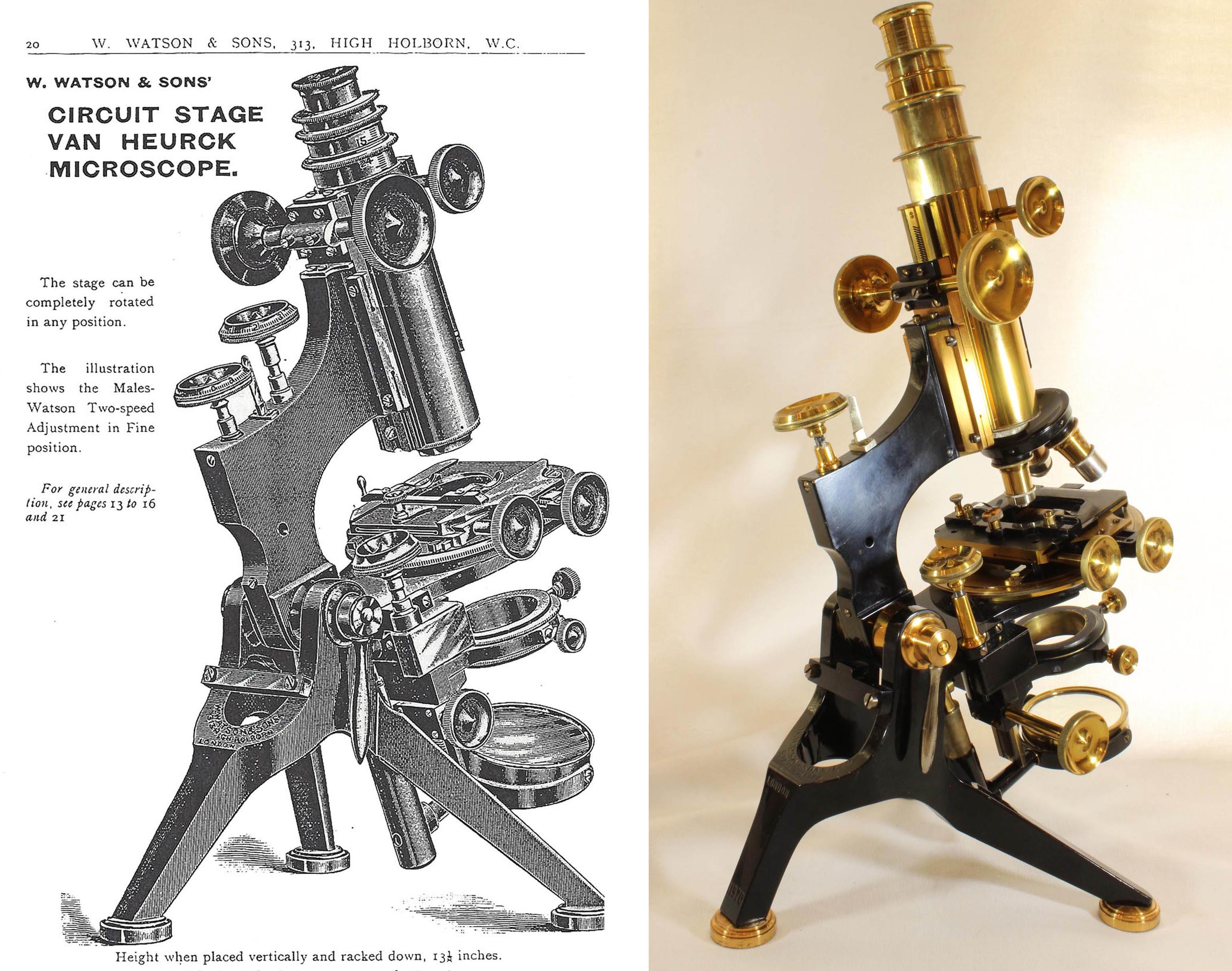 The
'Circuit Stage Van Heurck' was apparently first introduced about 1899
(as quoted in the Illustrated Annual of Microscopy for 1900). Like the Grand Model, it had complete rotation to the stage, but was otherwise identical to the smaller Van Heurck (now just called the Van Heurck without a letter or number), including the stage controls. Later on, the basic model simply became the 'No 1 Van Heurck'. Although listed in the Watson 1900 catalog, the Circuit Stage Van Heurck was not illustrated in that volume. The engraving to the left, from the 1902
catalog, illustrates the Circuit Stage Van Heurck with the optional Watson-Males two speed fine adjustment. It should be noted that from the start, the Terrell type stage could be ordered as an option for the Circuit Stage Model, thus some might look like a 'Grand' but would be
distinguishable only by size.
The
'Circuit Stage Van Heurck' was apparently first introduced about 1899
(as quoted in the Illustrated Annual of Microscopy for 1900). Like the Grand Model, it had complete rotation to the stage, but was otherwise identical to the smaller Van Heurck (now just called the Van Heurck without a letter or number), including the stage controls. Later on, the basic model simply became the 'No 1 Van Heurck'. Although listed in the Watson 1900 catalog, the Circuit Stage Van Heurck was not illustrated in that volume. The engraving to the left, from the 1902
catalog, illustrates the Circuit Stage Van Heurck with the optional Watson-Males two speed fine adjustment. It should be noted that from the start, the Terrell type stage could be ordered as an option for the Circuit Stage Model, thus some might look like a 'Grand' but would be
distinguishable only by size. | 'NO. 4 VAN HEURCK A' MODEL | ||
| DATES | STANDARD FEATURES |
OPTIONAL FEATURES |
|---|---|---|
| 1893 | Horseshoe foot, single draw, Mechanical Stage with separate controls for horizontal and vertical motion which rotates but not a full 360 degrees, Substage Fine Adjustment, Projecting upwards in back of stage, clamping lever for inclination Joint. The mechanical draw-tube length can vary from 160 to 260 mm. |
Tripod foot, Binocular Body,
Centering Screws
to stage with clamping, Rackwork rotation to stage, Divisions to stage,
Divisions to Horizontal and Vertical movements of stage, Rackwork
rotation to sub-stage, Clamping of
substage centering, |
| 1896 | The 'A' Stand is no longer offered in the catalog | |
| 'NO. 4 VAN HEURCK B' MODEL | ||
| DATES | STANDARD FEATURES |
OPTIONAL FEATURES |
| 1893 | Double Draw, with one Mechanical Draw tube, otherwise same as 'A' but with the extra draw-tube , the mechanical tube length has a longer range of from 142 to 310 mm. | Tripod Foot, Binocular Body |
| 1896 | Tripod Foot now standard, otherwise, the same options as 1893 | same as 1893 'A' stand, except now the Horseshoe foot was optional. |
| VAN HEURCK NO. 1 | ||
| DATES | STANDARD FEATURES |
OPTIONAL FEATURES |
| 1900 | Same as Van Heurck B of 1896 | Same as 1896 with additional option of Strnger's fine adjustment |
| 1902 | same | Same but also the Males-Watson fine adjustment and the Spindle head fine adjustment AND hinged substage which can be turned aside out of the optical axis |
| 1906 | same | same |
| 1912 | same except now the substage fine adjustment is an option | Choice of above or below stage substage fine adjustment |
| 1918 | same except now all Van Heurcks have hinged substage standard, which allows the substage to be turned aside and out of the optical axis | same as 1912 |
| 1921 | same as 1912, but now the substage bar extension sliding on dovetail to allow greater range of accessories of different heights as was previously only offered for the Grand, then the Circuit stage, is now offered for all Van Heurcks | |
| 1923 | ||
| VAN HEURCK CIRCUIT STAGE MODEL | ||
| DATES | STANDARD FEATURES |
OPTIONAL FEATURES |
| 1900 | Identical to No. 1 but with complete stage rotation | Identical to No. 1 |
| 1906 | Same as 1900 | Same as 1900 |
| 1912 | same except now the substage fine adjustment is an option | Choice of above or below stage control of substage fine adjustment |
| 1918 | same except now all Van Heurcks have hinged substage standard, which allows the substage to be turned aside and out of the optical axis | same as 1912, but now the substage bar extension sliding on dovetail to allow greater range of accessories of different heights as was previously only offered for the Grand |
| 1921 | same as 1918 | same as 1918 |
| 1923 | ---- | ---- |
| VAN HEURCK GRAND MODEL | ||
| DATES | STANDARD FEATURES |
OPTIONAL FEATURES |
| 1894 | First Grand Van Heurck Sold | |
| 1896 | Identical to the Van Heurck 'B' Stand, with the addition of concentric controls for the mechanical stage, and extension of the stage and arm forward to allow complete stage rotation and larger overall size with wider foot spread. | Identical to Van Heurck 'B' model. |
| 1900 | Identical to Circuit stage Model, but larger | Identical to Circuit stage model but optionally the same stage as the No. 1 instead of fully rotating, reduced the price by 3 pounds. |
| 1902 | Identical to Circuit stage Model, but larger | Identical to Circuit stage model
but optionally the
same stage as the No. 1 instead of concentric controls, reduced the
price by 3 pounds. Also option of Stringer's fine
adjustment, or
Males-Watson Two speed fine adjustment, or Spindle Milled-head fine
adjustment, all at extra cost. Optional hinged substage so it can be swung out of the optical axis. Also a substage bar extension sliding on dovetail to allow greater range of accessories of different heights. |
| 1906 | Identical to 1902 | Same as 1902 but also offered the Scop Mechanical Stage instead of the usual circuit stage, price the same as the standard model. |
| 1912 | same | same as 1906 |
| 1918 | same except now all Van Heurcks have hinged substage standard, which allows the substage to be turned aside and out of the optical axis | |
| 1921 | Same | Side Limb or Horizonatal fine adjustment for same price. |